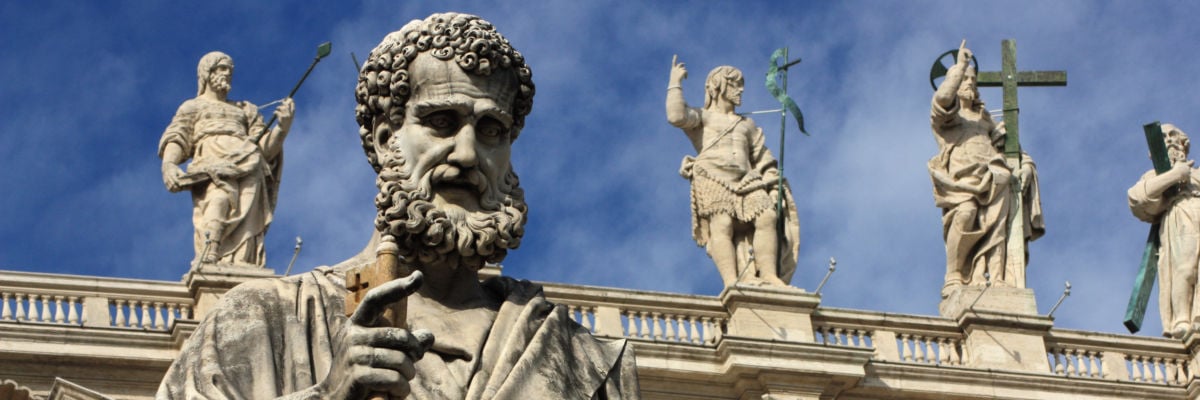
Few biblical passages have caused more apologist ink to be spilled than Matthew 16:17-19:
And Jesus answered him, “Blessed are you, Simon Bar-Jona! For flesh and blood has not revealed this to you, but my Father who is in heaven. And I tell you, you are Peter, and upon this rock I will build my church, and the powers of death shall not prevail against it. I will give you the keys of the kingdom of heaven, and whatever you bind on earth shall be bound in heaven, and whatever you loose on earth shall be loosed in heaven.”
For Catholics, this text is clear. All twelve apostles were present when Jesus promised to give to Peter alone the keys of the kingdom, symbolizing the authority of Christ—the authority of heaven—over the kingdom of heaven on Earth, the Church. Yet millions of Protestants believe there is a distinction to be made in the Greek text that would eliminate Peter from consideration for being the rock upon which Jesus would build his Church.
They claim the text actually says, “you are petros (which they translate as “small rock or stone”) and upon this petra (which they translate as “massive boulder”) I will build my Church.” On this reading, Peter is the “small rock” and Jesus is the “massive boulder.”
Here are just a few of the ways Catholic apologists have responded to this claim.
First, we have good reason to believe that the Gospel of Matthew was originally written in Aramaic, and Jesus almost certainly would have been speaking in Aramaic. This becomes crucial as even the Baptist biblical scholar, D.A. Carson, writes, in The Expositor’s Bible Commentary:
[T]he underlying Aramaic is in this case unquestionable; and most probably kepha was used in both clauses (“you are kepha” and “on this kepha”), since the word was used both for a name and for a “rock.” The Peshitta (written in Syriac, a language cognate with a dialect of Aramaic) makes no distinction between the words in the two clauses.
Second, in Koine Greek (the dialect of Greek used by the authors of the New Testament), petros and petra are masculine and feminine forms of words with the same root and the same definition—rock. There is no “small rock” to be found in the Greek text, either.
Third, petra was a very common term in Koine Greek, employed fifteen times to mean “rock,” “rocks,” or “rocky” in the New Testament. Petros is an ancient Greek term that was not commonly used in Koine Greek at all. In fact, it was never used in the New Testament except for Peter’s name after Jesus changed it from Simon to Peter.
So, St. Matthew would have used petra for “rock,” but in so doing he would have encountered a problem. Petra is a feminine noun, so it would have been improper to use it as a man’s name. This would be equivalent to calling a male “Valerie” or “Priscilla” in English. Hence, petros, a masculine word, was used instead of petra for Peter’s name.
Fourth, one of the most respected and referenced Greek dictionaries among Evangelicals is Gerhard Kittel’s Greek Theological Dictionary of the New Testament. In a candid statement about Matthew 16:18, Oscar Cullman, a contributing editor to this work, writes:
The obvious pun which has made its way into the Greek text . . . suggests a material identity between petra and Petros . . . as it is impossible to differentiate strictly between the two words. . . . Petros himself is this petra, not just his faith or his confession. . . . The idea of the Reformers that he is referring to the faith of Peter is quite inconceivable. . . . For there is no reference here to the faith of Peter. Rather, the parallelism of “thou art Rock” and “on this rock I will build” shows that the second rock can only be the same as the first. It is thus evident that Jesus is referring to Peter, to whom he has given the name Rock. . . . To this extent Roman Catholic exegesis is right and all Protestant attempts to evade this interpretation are to be rejected.
Fifth, if St. Matthew wanted to distinguish between sizes of rock in this passage, he would have more likely used lithos, which could refer to either a large rock or a small stone. However, there is a third word that St. Matthew could have used that in Koine Greek always means small stone: psephos. It is used twice in Rev. 2:17 as “small stone” when Jesus says,
To him who conquers I will give some of the hidden manna, and I will give him a white stone, with a new name written on the stone which no one knows except him who receives it.
And finally, if Matthew wanted to distinguish between rocks he most likely would not have said, “You are Peter and upon this rock…” He probably would have said words to the effect of, “You are Peter, but upon this rock…” in order to distinguish rocks.
The text is actually quite clear—Peter is the rock.



